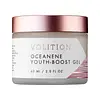What's inside
What's inside
 Key Ingredients
Key Ingredients

 Benefits
Benefits

 Concerns
Concerns

No concerns
 Ingredients Side-by-side
Ingredients Side-by-side

Water
Skin ConditioningCaprylic/Capric Triglyceride
MaskingGlycerin
HumectantTheobroma Grandiflorum Seed Butter
Skin ConditioningStearyl Alcohol
EmollientCetearyl Alcohol
EmollientButyrospermum Parkii Butter
Skin ConditioningCarthamus Tinctorius Seed Oil
MaskingPEG-100 Stearate
Elaeis Guineensis Oil
EmollientDimethicone
EmollientCetyl Esters
EmollientSaccharum Officinarum Extract
MoisturisingAsparagopsis Armata Extract
Skin ProtectingAscophyllum Nodosum Extract
Skin ConditioningGlycyrrhiza Glabra Root Extract
BleachingOlea Europaea Fruit Oil
MaskingHydrogenated Olive Oil
Skin ConditioningOlea Europaea Oil Unsaponifiables
Skin ConditioningCaffeine
Skin ConditioningAminopropyl Ascorbyl Phosphate
AntioxidantSodium Hyaluronate
HumectantSalicylic Acid
MaskingTocopherol
AntioxidantCetyl Alcohol
EmollientSorbitol
HumectantCetearyl Glucoside
EmulsifyingGlyceryl Stearate Citrate
EmollientSodium PCA
HumectantXanthan Gum
EmulsifyingCaprylyl Glycol
EmollientPhenoxyethanol
PreservativeWater, Caprylic/Capric Triglyceride, Glycerin, Theobroma Grandiflorum Seed Butter, Stearyl Alcohol, Cetearyl Alcohol, Butyrospermum Parkii Butter, Carthamus Tinctorius Seed Oil, PEG-100 Stearate, Elaeis Guineensis Oil, Dimethicone, Cetyl Esters, Saccharum Officinarum Extract, Asparagopsis Armata Extract, Ascophyllum Nodosum Extract, Glycyrrhiza Glabra Root Extract, Olea Europaea Fruit Oil, Hydrogenated Olive Oil, Olea Europaea Oil Unsaponifiables, Caffeine, Aminopropyl Ascorbyl Phosphate, Sodium Hyaluronate, Salicylic Acid, Tocopherol, Cetyl Alcohol, Sorbitol, Cetearyl Glucoside, Glyceryl Stearate Citrate, Sodium PCA, Xanthan Gum, Caprylyl Glycol, Phenoxyethanol
Water
Skin ConditioningButylene Glycol
HumectantC15-19 Alkane
SolventC9-12 Alkane
SolventCapryloyl Glycerin/Sebacic Acid Copolymer
Skin ConditioningDiheptyl Succinate
EmollientGlycerin
HumectantPelvetia Canaliculata Extract
Skin ProtectingMagnesium Ascorbyl Phosphate
AntioxidantSodium Hyaluronate
HumectantAloe Barbadensis Leaf Juice
Skin ConditioningCamellia Sinensis Leaf Extract
AntimicrobialPolyglyceryl-2 Dipolyhydroxystearate
Skin ConditioningTocopheryl Acetate
AntioxidantAcrylates/C10-30 Alkyl Acrylate Crosspolymer
Emulsion StabilisingAmmonium Acryloyldimethyltaurate/Vp Copolymer
Lauryl Glucoside
CleansingCitric Acid
BufferingSorbic Acid
PreservativePotassium Sorbate
PreservativeSodium Benzoate
MaskingPhenoxyethanol
PreservativeEthylhexylglycerin
Skin ConditioningSodium Hydroxide
BufferingWater, Butylene Glycol, C15-19 Alkane, C9-12 Alkane, Capryloyl Glycerin/Sebacic Acid Copolymer, Diheptyl Succinate, Glycerin, Pelvetia Canaliculata Extract, Magnesium Ascorbyl Phosphate, Sodium Hyaluronate, Aloe Barbadensis Leaf Juice, Camellia Sinensis Leaf Extract, Polyglyceryl-2 Dipolyhydroxystearate, Tocopheryl Acetate, Acrylates/C10-30 Alkyl Acrylate Crosspolymer, Ammonium Acryloyldimethyltaurate/Vp Copolymer, Lauryl Glucoside, Citric Acid, Sorbic Acid, Potassium Sorbate, Sodium Benzoate, Phenoxyethanol, Ethylhexylglycerin, Sodium Hydroxide
Ingredients Explained
These ingredients are found in both products.
Ingredients higher up in an ingredient list are typically present in a larger amount.
Glycerin is already naturally found in your skin. It helps moisturize and protect your skin.
A study from 2016 found glycerin to be more effective as a humectant than AHAs and hyaluronic acid.
As a humectant, it helps the skin stay hydrated by pulling moisture to your skin. The low molecular weight of glycerin allows it to pull moisture into the deeper layers of your skin.
Hydrated skin improves your skin barrier; Your skin barrier helps protect against irritants and bacteria.
Glycerin has also been found to have antimicrobial and antiviral properties. Due to these properties, glycerin is often used in wound and burn treatments.
In cosmetics, glycerin is usually derived from plants such as soybean or palm. However, it can also be sourced from animals, such as tallow or animal fat.
This ingredient is organic, colorless, odorless, and non-toxic.
Glycerin is the name for this ingredient in American English. British English uses Glycerol/Glycerine.
Learn more about GlycerinPhenoxyethanol is a preservative that has germicide, antimicrobial, and aromatic properties. Studies show that phenoxyethanol can prevent microbial growth. By itself, it has a scent that is similar to that of a rose.
It's often used in formulations along with Caprylyl Glycol to preserve the shelf life of products.
Sodium Hyaluronate is hyaluronic acid's salt form. It is commonly derived from the sodium salt of hyaluronic acid.
Like hyaluronic acid, it is great at holding water and acts as a humectant. This makes it a great skin hydrating ingredient.
Sodium Hyaluronate is naturally occurring in our bodies and is mostly found in eye fluid and joints.
These are some other common types of Hyaluronic Acid:
Learn more about Sodium HyaluronateWater. It's the most common cosmetic ingredient of all. You'll usually see it at the top of ingredient lists, meaning that it makes up the largest part of the product.
So why is it so popular? Water most often acts as a solvent - this means that it helps dissolve other ingredients into the formulation.
You'll also recognize water as that liquid we all need to stay alive. If you see this, drink a glass of water. Stay hydrated!
Learn more about Water